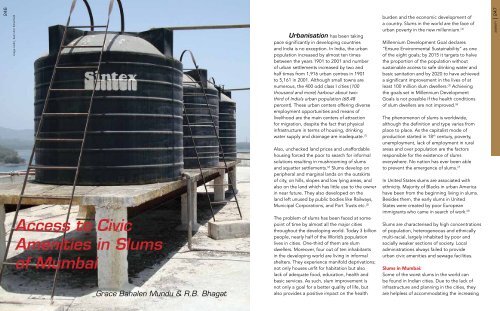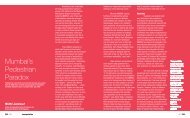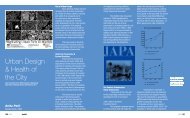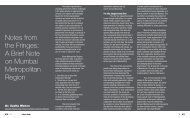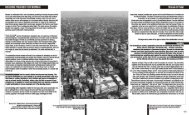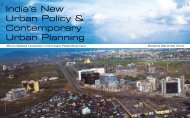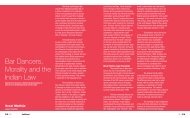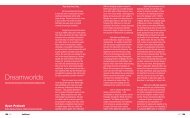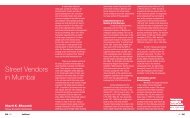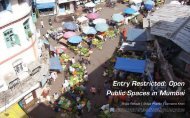Access to Civic Amenities in Slums of Mumbai.pdf - Urban Design ...
Access to Civic Amenities in Slums of Mumbai.pdf - Urban Design ...
Access to Civic Amenities in Slums of Mumbai.pdf - Urban Design ...
- No tags were found...
Create successful ePaper yourself
Turn your PDF publications into a flip-book with our unique Google optimized e-Paper software.
246image credit_ Kar<strong>in</strong> Ann Schierhold<strong>Access</strong> <strong>to</strong> <strong>Civic</strong><strong>Amenities</strong> <strong>in</strong> <strong>Slums</strong><strong>of</strong> <strong>Mumbai</strong>_Grace Bahalen Mundu & R.B. Bhagat<strong>Urban</strong>isation has been tak<strong>in</strong>gpace significantly <strong>in</strong> develop<strong>in</strong>g countriesand India is no exception. In India, the urbanpopulation <strong>in</strong>creased by almost ten timesbetween the years 1901 <strong>to</strong> 2001 and number<strong>of</strong> urban settlements <strong>in</strong>creased by two andhalf times from 1,916 urban centres <strong>in</strong> 1901<strong>to</strong> 5,161 <strong>in</strong> 2001. Although small <strong>to</strong>wns arenumerous, the 400 odd class I cities (100thousand and more) harbour about twothird<strong>of</strong> India’s urban population (68.48percent). These urban centers <strong>of</strong>fer<strong>in</strong>g diverseemployment opportunities and means <strong>of</strong>livelihood are the ma<strong>in</strong> centers <strong>of</strong> attractionfor migration, despite the fact that physical<strong>in</strong>frastructure <strong>in</strong> terms <strong>of</strong> hous<strong>in</strong>g, dr<strong>in</strong>k<strong>in</strong>gwater supply and dra<strong>in</strong>age are <strong>in</strong>adequate. (1)Also, unchecked land prices and unaffordablehous<strong>in</strong>g forced the poor <strong>to</strong> search for <strong>in</strong>formalsolutions result<strong>in</strong>g <strong>in</strong> mushroom<strong>in</strong>g <strong>of</strong> slumsand squatter settlements. (2) <strong>Slums</strong> develop onperipheral and marg<strong>in</strong>al lands on the outskirts<strong>of</strong> city, on hills, slopes and low ly<strong>in</strong>g areas, andalso on the land which has little use <strong>to</strong> the owner<strong>in</strong> near future. They also developed on theland left unused by public bodies like Railways,Municipal Corporations, and Port Trusts etc. (3)The problem <strong>of</strong> slums has been faced at somepo<strong>in</strong>t <strong>of</strong> time by almost all the major citiesthroughout the develop<strong>in</strong>g world. Today 3 billionpeople, nearly half <strong>of</strong> the World’s populationlives <strong>in</strong> cities. One-third <strong>of</strong> them are slumdwellers. Moreover, four out <strong>of</strong> ten <strong>in</strong>habitants<strong>in</strong> the develop<strong>in</strong>g world are liv<strong>in</strong>g <strong>in</strong> <strong>in</strong>formalshelters. They experience manifold deprivations;not only houses unfit for habitation but alsolack <strong>of</strong> adequate food, education, health andbasic services. As such, slum improvement isnot only a goal for a better quality <strong>of</strong> life, butalso provides a positive impact on the healthburden and the economic development <strong>of</strong>a country. <strong>Slums</strong> <strong>in</strong> the world are the face <strong>of</strong>urban poverty <strong>in</strong> the new millennium. (4)Millennium Development Goal declares“Ensure Environmental Susta<strong>in</strong>ability” as one<strong>of</strong> the eight goals; by 2015 it targets <strong>to</strong> halvethe proportion <strong>of</strong> the population withoutsusta<strong>in</strong>able access <strong>to</strong> safe dr<strong>in</strong>k<strong>in</strong>g water andbasic sanitation and by 2020 <strong>to</strong> have achieveda significant improvement <strong>in</strong> the lives <strong>of</strong> atleast 100 million slum dwellers. (5) Achiev<strong>in</strong>gthe goals set <strong>in</strong> Millennium DevelopmentGoals is not possible if the health conditions<strong>of</strong> slum dwellers are not improved. (6)The phenomenon <strong>of</strong> slums is worldwide,although the def<strong>in</strong>ition and type varies fromplace <strong>to</strong> place. As the capitalist mode <strong>of</strong>production started <strong>in</strong> 18 th century, poverty,unemployment, lack <strong>of</strong> employment <strong>in</strong> ruralareas and over population are the fac<strong>to</strong>rsresponsible for the existence <strong>of</strong> slumseverywhere. No nation has ever been able<strong>to</strong> prevent the emergence <strong>of</strong> slums. (7)In United States slums are associated withethnicity. Majority <strong>of</strong> Blacks <strong>in</strong> urban Americahave been from the beg<strong>in</strong>n<strong>in</strong>g liv<strong>in</strong>g <strong>in</strong> slums.Besides them, the early slums <strong>in</strong> UnitedStates were created by poor Europeanimmigrants who came <strong>in</strong> search <strong>of</strong> work. (8)<strong>Slums</strong> are characterised by high concentrations<strong>of</strong> population, heterogeneous and ethnicallymulti-racial, largely <strong>in</strong>habited by poor andsocially weaker sections <strong>of</strong> society. Localadm<strong>in</strong>istrations always failed <strong>to</strong> provideurban civic amenities and sewage facilities.<strong>Slums</strong> <strong>in</strong> <strong>Mumbai</strong>:Some <strong>of</strong> the worst slums <strong>in</strong> the world canbe found <strong>in</strong> Indian cities. Due <strong>to</strong> the lack <strong>of</strong><strong>in</strong>frastructure and plann<strong>in</strong>g <strong>in</strong> the cities, theyare helpless <strong>of</strong> accommodat<strong>in</strong>g the <strong>in</strong>creas<strong>in</strong>gAMENITY | 247
AMENITY | 248flow <strong>of</strong> migrants from the rural areas. (9) <strong>Slums</strong> arel<strong>in</strong>ked with the British rule <strong>in</strong> India. A majority <strong>of</strong>the rural migrants, displaced <strong>in</strong> the process <strong>of</strong>colonial development, migrated <strong>to</strong> large citiesfor seek<strong>in</strong>g employment. The <strong>in</strong>dustries and cityadm<strong>in</strong>istration were not concerned <strong>to</strong> provideadequate shelters <strong>to</strong> these migrants. In somecities, particularly <strong>in</strong> the states <strong>of</strong> Maharashtraand Gujarat, <strong>in</strong>dustrialists tried <strong>to</strong> attract andreta<strong>in</strong> them by provid<strong>in</strong>g small tenements ormulti s<strong>to</strong>ried row houses <strong>in</strong> the pattern <strong>of</strong> armybarracks, called ‘Chawls’, mostly built <strong>in</strong> 19 thcentury. Over time, due <strong>to</strong> lack <strong>of</strong> ma<strong>in</strong>tenance,dilapidation etc. most <strong>of</strong> the chawls havebecome extremely poor <strong>in</strong> terms <strong>of</strong> quality <strong>of</strong>life. (10) Poverty is the ma<strong>in</strong> reason beh<strong>in</strong>d theslums and slums breed hopelessness and crime.The key reason is the slow economic progress.By mid sixties <strong>in</strong> India; <strong>Mumbai</strong>, Kolkata, Delhi &all other large cities were dotted with slums. (11)The ma<strong>in</strong> reason beh<strong>in</strong>d the orig<strong>in</strong> <strong>of</strong> Bombay’sslums can be traced <strong>to</strong> its development as animportant political and economic centre <strong>of</strong> thecountry. It fasc<strong>in</strong>ated a large number <strong>of</strong> peoplefrom the rural and small <strong>to</strong>wn areas. After theSecond World War there was a subsequentrise <strong>in</strong> population due <strong>to</strong> economic upheaval.Private enterprise constructed houses with amaximum pr<strong>of</strong>it motive which gave birth <strong>to</strong>build<strong>in</strong>gs known as chawls. These chawls consis<strong>to</strong>f number <strong>of</strong> tenements, usually one small roomfor each family and served by water-closetsand water taps for all families. Some <strong>of</strong> themare even five <strong>to</strong> six s<strong>to</strong>ried. Due <strong>to</strong> lack <strong>of</strong> <strong>to</strong>wnplann<strong>in</strong>g and satisfac<strong>to</strong>ry standards laid downby law <strong>in</strong> respect <strong>to</strong> m<strong>in</strong>imum accommodationand sanitation, the growth <strong>of</strong> <strong>Mumbai</strong> wenthaphazard. And the gradual decay andneglect<strong>in</strong>g <strong>of</strong> chawls made them unfit for humanliv<strong>in</strong>g. Later on these chawls got overcrowdedand congested, lack <strong>of</strong> hygiene and sanitationconverted them <strong>to</strong> slums. <strong>Slums</strong> can be grouped<strong>in</strong><strong>to</strong>: chawls, semi permanent residentialstructure and unauthorised huts put up onvacant lands. Various wards <strong>of</strong> Bombay reportedslums before the Second World War. Populationand urban growth has taken place at such arapid pace that the hous<strong>in</strong>g sec<strong>to</strong>r has not beenable <strong>to</strong> deal with this problem result<strong>in</strong>g <strong>in</strong><strong>to</strong>development <strong>of</strong> numerous slums <strong>in</strong> the city. (12)The biggest slum <strong>of</strong> Asia, Dharavi is situated<strong>in</strong> G ward <strong>of</strong> <strong>Mumbai</strong> city, compris<strong>in</strong>g <strong>of</strong>small fishermen villages and low ly<strong>in</strong>g marshyland. After the post-war period there wasa gradual rise <strong>in</strong> population and result<strong>in</strong>gshortage <strong>of</strong> hous<strong>in</strong>g. These migrants chosethe so called slum area for their huts, madeup <strong>of</strong> pieces <strong>of</strong> old t<strong>in</strong>, bamboo etc. Thesehuts are characterised by lack <strong>of</strong> openspace between the huts and waste waterfrom the huts without the proper dra<strong>in</strong>agefacility result<strong>in</strong>g <strong>in</strong><strong>to</strong> dampness. (13)As awareness and utilisation <strong>of</strong> loan facility<strong>in</strong> almost all slum areas was very low, thisresulted <strong>in</strong><strong>to</strong> almost no utilisation <strong>of</strong> availablecredit facility. Study shows that <strong>in</strong> order<strong>to</strong> improve the life <strong>of</strong> slum dwellers major<strong>in</strong>itiatives are required at all fronts. It <strong>in</strong>cludesprovision <strong>of</strong> basic amenities, educationand vocational tra<strong>in</strong><strong>in</strong>g, health care andpromotion <strong>of</strong> <strong>in</strong>come generat<strong>in</strong>g activities. (14)In the earlier studies due <strong>to</strong> the lack <strong>of</strong>data not much work has been done onthe slum population <strong>of</strong> metropolitan cities.Comprehensive <strong>in</strong>formation on the slums isessential for the formulation <strong>of</strong> an effectivepolicy for their improvement and rehabilitationas they have not received due attention<strong>in</strong> urban plann<strong>in</strong>g and have rema<strong>in</strong>ed anarea <strong>of</strong> neglect. So there is a need <strong>to</strong> studythe characteristics <strong>of</strong> slum population. Thema<strong>in</strong> objective <strong>of</strong> this paper is <strong>to</strong> study theconditions <strong>of</strong> slum households <strong>in</strong> <strong>Mumbai</strong> ata ward level <strong>in</strong> term <strong>of</strong> access <strong>to</strong> electricity,tap water, <strong>to</strong>ilet and sewer facility.Data:Both published and unpublished data from the2001 Census have been used <strong>in</strong> this study. Inthe 2001 Census, for the first time, an attemptwas made <strong>to</strong> collect detailed demographic dataabout slums across the country, particularly, <strong>in</strong>cities and <strong>to</strong>wns hav<strong>in</strong>g population <strong>of</strong> 50,000or above (as <strong>of</strong> 1991). The <strong>in</strong>formation ondifferent characteristics <strong>of</strong> the slum dwellershas been collected through the same censusquestionnaire <strong>of</strong> household schedule, whichwas canvassed for the population enumeration<strong>in</strong> the country at the 2001 census. Slumpopulation has been reported from 640 citiesand <strong>to</strong>wns <strong>of</strong> 26 States/Union Terri<strong>to</strong>ries (UT).More than 72,000 enumeration blocks havebeen identified as slum enumeration blocks <strong>in</strong>these cities/<strong>to</strong>wns which constitute nearly 22%<strong>of</strong> the <strong>to</strong>tal enumeration blocks <strong>in</strong> urban areas.In the rema<strong>in</strong><strong>in</strong>g 9 States/Union Terri<strong>to</strong>riesthere were no identified slums. While censushas published demographic characteristics <strong>of</strong>slums, the <strong>in</strong>formation about basic amenitieswas available <strong>in</strong> unpublished form until recently.We have been provided the data by the Census<strong>of</strong>fice on number <strong>of</strong> slums ward wise, number<strong>of</strong> slum households, length <strong>of</strong> paved roads<strong>in</strong> slums, number <strong>of</strong> tap water connections,number <strong>of</strong> latr<strong>in</strong>es (private and community), type<strong>of</strong> sewerage system (sewerage, open surfacedra<strong>in</strong>s) and method <strong>of</strong> disposal <strong>of</strong> night soil.This study utilises this data and presentsward wise distribution <strong>of</strong> population <strong>in</strong>slums, distribution <strong>of</strong> tap water facility,electricity connections, <strong>to</strong>ilet facility,and sewerage system <strong>in</strong> both notifiedand non-notified slums <strong>in</strong> <strong>Mumbai</strong>.Def<strong>in</strong>itions and Concept <strong>of</strong> <strong>Slums</strong>Accord<strong>in</strong>g <strong>to</strong> Census <strong>of</strong> India 2001, thedef<strong>in</strong>ition <strong>of</strong> slums is as follows --i. All specified areas <strong>in</strong> a <strong>to</strong>wn orcity notified as ‘slum’ by State, UTAdm<strong>in</strong>istration or Local Governmentunder any Act <strong>in</strong>clud<strong>in</strong>g a ‘Slum Act’.ii. All areas recognised as ‘slum’ by State, UTAdm<strong>in</strong>istration or Local Government, Hous<strong>in</strong>gand Slum Boards, which may have not beenformally notified as slum under any act;iii. A compact area <strong>of</strong> at least 300 populationor about 60-70 households <strong>of</strong> poorlybuilt congested tenements, <strong>in</strong> unhygienicenvironment usually with <strong>in</strong>adequate<strong>in</strong>frastructure and lack<strong>in</strong>g <strong>in</strong> propersanitation and dr<strong>in</strong>k<strong>in</strong>g water facility.Table1: Size and Growth <strong>of</strong> Population<strong>in</strong> Greater <strong>Mumbai</strong>, 1981-2000.YearGreater<strong>Mumbai</strong>(M. Corp.)Greater<strong>Mumbai</strong>(U.A)Greater<strong>Mumbai</strong>(M. Corp.)Greater<strong>Mumbai</strong>(U.A)Population Annual Growth Rate (%)1981 8,243,405 9,421,962 - -1991 9,925,891 12,596,243 1.86 2.902001 11,914,398 16,434,386 1.83 2.65Note. U.A. – <strong>Urban</strong> AgglomerationM. Corp. -Municipal CorporationSource: Registrar General and Census Commissioner,2001, Census <strong>of</strong> India: Maharashtra Population Datawith Slum Population <strong>in</strong> <strong>Urban</strong> Units, <strong>Mumbai</strong>Table 1 presents the population size and growthrate <strong>of</strong> Greater <strong>Mumbai</strong> (Municipal Corporation and<strong>Urban</strong> Agglomeration) for the year 1981 <strong>to</strong> 2001. Thetable shows that the population <strong>of</strong> Greater <strong>Mumbai</strong><strong>in</strong>creased more <strong>in</strong> <strong>Mumbai</strong> <strong>Urban</strong> Agglomerationarea compared <strong>to</strong> the city area with<strong>in</strong> the <strong>Mumbai</strong>Municipal Corporation. On the other hand, thegrowth rate <strong>in</strong> <strong>Mumbai</strong> Municipal Corporationrema<strong>in</strong>ed almost stable <strong>of</strong> 1.86 <strong>to</strong> 1.83 percent perannum, whereas the growth rate <strong>in</strong> <strong>Mumbai</strong> <strong>Urban</strong>Agglomeration has decl<strong>in</strong>ed from 2.90 percentper annum dur<strong>in</strong>g 1981-1991 <strong>to</strong> 2.65 percentdur<strong>in</strong>g 1991-2001. This paper aims <strong>to</strong> present theconditions <strong>of</strong> slum dwellers <strong>in</strong> <strong>Mumbai</strong> city (M. Corp)with regard <strong>to</strong> their access <strong>to</strong> tap water, electricity,<strong>to</strong>ilet facility and sewerage at the ward level.AMENITY | 249
AMENITY | 254Table 4: Ward Wise Distribution <strong>of</strong> Sewerage System <strong>in</strong> <strong>Slums</strong> <strong>of</strong> <strong>Mumbai</strong>No. <strong>of</strong> Name <strong>of</strong> WardsSewerage SystemWardsS OSD S/OSD1 (Ward A) Colaba Area S - -2 (Ward B) Sandhurst Rd. S - -3 (Ward C) Mar<strong>in</strong>e L<strong>in</strong>es There is no <strong>Slums</strong> with<strong>in</strong> the Ward Limits4 (Ward D) Grant Road S - -5 (Ward E) Byculla S - -6 (Ward F/S)Parel - OSD -7 (Ward F/N) Matunga - OSD -8 (Ward G/N) Dadar S - -9 (Ward G/S) Elph<strong>in</strong>s<strong>to</strong>ne Rd. S - -10 (Ward H/W) Bandra S - -11 (Ward H/E) Khar Santacruz S - -12 (Ward K/E) Andheri (E) OSD -13 (Ward K/W) Andheri (W) S - -14 (Ward P/S) Goregaon - S/OSD15 (Ward P/N) Malad S -16 (Ward R/S) Kandivali - - S/OSD17 (Ward R/C) Dahisar - OSD -18 (Ward R/N) Borivali - OSD -19 (Ward L) Kurla - OSD -20 (Ward M/W) Chembur (W) - OSD -21 (Ward M/E) Chembur (E) - OSD -22 (Ward N) Ghatkopar - - S/OSD23 (Ward S) Bhandup - OSD -24 (Ward T) Mulund - OSD -AMENITY | 255Total 24 Wards 10 10 3NoteS= Covered SewerOSD=Open Surface Dra<strong>in</strong>sS/OSD= Covered Sewer/Open Surface Dra<strong>in</strong>sSource: Census <strong>of</strong> India 2001 unpublished dataFigure 2Table 4 presents ward wise distribution <strong>of</strong> sewerage system i.e., households have some facility<strong>of</strong> water outlet connected <strong>to</strong> some form <strong>of</strong> dra<strong>in</strong>age system <strong>to</strong> carry away the watse-watergenerated by them. at the ward level, the table shows that ten wards like Colabe, SandhurstRd., Grant Rd., Byculla, Dadar, Elph<strong>in</strong>s<strong>to</strong>ne Rd., Bandra, Khar, Santacruz, Andheri (W) and Maladreported <strong>to</strong> have sewerage system.
AMENITY | 256Table 5: Distribution <strong>of</strong> Notified <strong>Slums</strong> <strong>in</strong> <strong>Mumbai</strong> City, Census <strong>of</strong> India, 2001No. <strong>of</strong>WardsName <strong>of</strong> Wards Number <strong>of</strong> Notified <strong>Slums</strong> Percentage <strong>of</strong> Notified <strong>Slums</strong>1 (Ward A) Colaba 0 02 (Ward B) Sandhurst Rd. 0 03 (Ward C) Mar<strong>in</strong>e L<strong>in</strong>es There is no <strong>Slums</strong> with<strong>in</strong> the Ward Limits4 (Ward D) Grant Road 18 1005 (Ward E) Byulla 11 1006 (Ward F/S)Parel 48 1007 (Ward F/N) Matunga 0 08 (Ward G/N) Dadar 74 1009 (Ward G/S) Elph<strong>in</strong>s<strong>to</strong>ne Rd. 71 10010 (Ward H/W) Bandra 3 9.3811 (Ward H/E) Khar Santacruz 18 90.0012 (Ward K/E) Andheri (E) 1 10013 (Ward K/W) Andheri (W) 2 40.0014 (Ward P/S) Goregaon 3 10015 (Ward P/N) Malad 6 10016 (Ward R/S) Kandivali 2 8.0017 (Ward R/C) Dahisar 82 10018 (Ward R/N) Borivali 30 10019 (Ward L) Kurla 232 10020 (Ward M/W) Chembur (W) 33 10021 (Ward M/E) Chembur (E) 39 10022 (Ward N) Ghatkopar 22 37.2923 (Ward S) Bhandup 188 10024 (Ward T) Mulund 65 81.25AMENITY | 257Total 24 Wards 948 85.87Table 5 presents ward wise percent distribution <strong>of</strong> notified slums <strong>in</strong> <strong>Mumbai</strong> city. Most <strong>of</strong> the slums arehundred percent notified <strong>in</strong> fourteen wards which are situated <strong>in</strong> Grant Road, Parel, Byculla, Elph<strong>in</strong>s<strong>to</strong>neRd., Dadar, Goregaon, Malad, Borivali, Dahisar, Chembur (E), Chembur (W) and Bhandup.Figure 3
AMENITY | 258Notified <strong>Slums</strong>: Some areas such as Colaba,Sandhurst and Matunga have no notifiedslums. Notified means, they are declaredas slums by the Government or MunicipalAuthority and they deserve the basic m<strong>in</strong>imumrequirements <strong>of</strong> shelter (see Table 5).Slum Rehabilitation Policy <strong>in</strong> <strong>Mumbai</strong>:S<strong>in</strong>ce <strong>in</strong>dependence there have been someefforts at rehabilitat<strong>in</strong>g the population <strong>of</strong> slumsand improv<strong>in</strong>g their conditions <strong>of</strong> liv<strong>in</strong>g. In 1985,the government tried <strong>to</strong> rectify the problemby launch<strong>in</strong>g the Slum Upgradation Project.It <strong>of</strong>fered secure long-term legal plot <strong>to</strong> slumhouseholds on the basis that they would <strong>in</strong>vest<strong>in</strong> their hous<strong>in</strong>g. By generat<strong>in</strong>g an <strong>in</strong>terest <strong>in</strong> thehous<strong>in</strong>g and by guarantee<strong>in</strong>g home ownership<strong>to</strong> the slum households, it is hoped <strong>to</strong> obliterateslums. Unfortunately the program targetedonly 10-12 percent <strong>of</strong> the slum households i.e.,those who were capable <strong>of</strong> upgrad<strong>in</strong>g theirhomes. It disregarded those who did not havehomes at all. Slum Rehabilitation Act 1995 waspassed by Govt. <strong>of</strong> Maharashtra <strong>to</strong> protectthe rights <strong>of</strong> slum dwellers and promote thedevelopment <strong>of</strong> slum areas. The Act protectedfrom eviction anyone who could produce adocument provid<strong>in</strong>g they lived <strong>in</strong> the city beforeJanuary 1995, regardless if they lived on thepavement or other k<strong>in</strong>ds <strong>of</strong> municipal land.The free hous<strong>in</strong>g scheme for slum-dwellerswas severely criticised as the slum policy reliesonly on the participation <strong>of</strong> builders. However,the scheme is good because it envisages that<strong>in</strong>stead <strong>of</strong> resettlement <strong>of</strong> slum dwellers <strong>to</strong>another place it is better <strong>to</strong> upgrade theseslums by provid<strong>in</strong>g better hous<strong>in</strong>g, dr<strong>in</strong>k<strong>in</strong>gwater facility, electricity, <strong>to</strong>ilet facility and properdra<strong>in</strong>age systems at their own locations.Conclud<strong>in</strong>g Remark:A large number <strong>of</strong> slum people are migrants;most <strong>of</strong> them belong <strong>to</strong> the lower socioeconomic group and come from differentparts <strong>of</strong> the country. The majority <strong>of</strong> the slumpopulation is concentrated <strong>in</strong> core areas <strong>of</strong> thecity because they want <strong>to</strong> live nearer <strong>to</strong> theirwork<strong>in</strong>g places and contribute significantly<strong>to</strong> the economic activity <strong>of</strong> the city. Most <strong>of</strong>places where slum dwellers live are unhygienic.In ra<strong>in</strong>y season they are more vulnerable <strong>to</strong>the diseases because most <strong>of</strong> the slums are<strong>in</strong> the low ly<strong>in</strong>g areas especially <strong>in</strong> the coastalcities like <strong>Mumbai</strong>. These slums are not onlycongested places, but also have open sewerageand lack private <strong>to</strong>ilets. Wherever community<strong>to</strong>ilets are available they are not properlyma<strong>in</strong>ta<strong>in</strong>ed and as a result people resort <strong>to</strong>open defecation. This is a big problem <strong>in</strong><strong>Mumbai</strong> which warrants immediate attention.AMENITY | 259_______________________________________________________________________________References1. Registrar General, India, (2001), AnalyticalReport on Hous<strong>in</strong>g <strong>Amenities</strong>, Series I,Census <strong>of</strong> India, Delhi.2. Retnaraj, D., (2001), “Fast Grow<strong>in</strong>g Cities,Spurt <strong>in</strong> Land Prices and <strong>Urban</strong> <strong>Slums</strong>: TheKerala Experience.” IASSI Quarterly Vol 20,No. 2, Pages 123-133.3. Nangia, Parveen and Gupta, Kamla, (1993-94), Morphology <strong>of</strong> <strong>Slums</strong> <strong>in</strong> Thane. ReportSeries, No 6, International Institute forPopulation Sciences, <strong>Mumbai</strong>, India.4. United Nations Human settlementsProgramme (UN-HABITAT), (2003), <strong>Slums</strong><strong>of</strong> the World: The face <strong>of</strong> urban poverty<strong>in</strong> the new millennium? Work<strong>in</strong>g 1 Paper.accessed on 18 May 2009 available athttp://www.unhabitat.org/pmss/getPage.asp?page=book View&book=20575. United Nations Human SettlementsProgramme (UN-HABITAT), State <strong>of</strong> WorldCities 2006/07, accessed on 18 May 2009available at http://www.unhabitat.org/downloads/docs/5636 _27492_SOWCR%2022.<strong>pdf</strong>6. Agarwal, S., A. Satyavada, S. Kaushik, andR. Kumar, (2007),” <strong>Urban</strong>ization, <strong>Urban</strong>Poverty and Health <strong>of</strong> the <strong>Urban</strong> Poor:Status, Challenges and the Way Forward”,Demography India, Vol 36 No 1, pages 121-134.7. Abrams, Charles, (1970), “<strong>Slums</strong>”, <strong>in</strong> (edi<strong>to</strong>rs)Desai, A. R. and S. Devadas Pillai <strong>Slums</strong> and<strong>Urban</strong>ization, Popular Prakashan, Bombay,pages 9-14.8. Grodz<strong>in</strong>s, Mor<strong>to</strong>n, (1970), “The New Shame<strong>of</strong> The Cities,” <strong>in</strong> (edi<strong>to</strong>rs) Desai, A. R. andS. Devadas Pillai, <strong>Slums</strong> and <strong>Urban</strong>ization,Popular Prakashan, Bombay, pages 77-81.9. Desai, A. R., and S. D. Pillai, (1970), <strong>Slums</strong> and<strong>Urban</strong>ization, Popular Prakashan, Bombaypages, 149-152.10. Kundu, A., (2007), “Stigmatization <strong>of</strong> <strong>Urban</strong>Processes <strong>in</strong> India: An Analysis <strong>of</strong> Term<strong>in</strong>ologywith Special Reference <strong>to</strong> Slum Situations”Work<strong>in</strong>g Paper No 4, December 1999,accessed on 24 August 2007, available atwww.unesco.org/shs/most.html.11. South Asian Analysis Group, (2006),“Poverty and <strong>Slums</strong> <strong>in</strong> India: Impact <strong>of</strong>Chang<strong>in</strong>g Economic Landscape,” PaperNo 1769, by Sud, Hari, accessed on 25August 2007 available at http://www.southasiananalysis,org/%5C paper18%5Cpaper1769.html.12. Bombay Municipal Corporation, (1956-57),“<strong>Slums</strong> <strong>in</strong> Bombay,” Repr<strong>in</strong>ted from BriefReport on the Survey <strong>of</strong> Old Build<strong>in</strong>gs <strong>in</strong>City (1956-57), <strong>in</strong> (edi<strong>to</strong>rs) A. R. Desai andS. Devadas Pillai, <strong>Slums</strong> and <strong>Urban</strong>ization,Bombay Popular Prakashan, Bombay, pages153-160.13. See reference 12, Bombay MunicipalCorporation, (1956-57), “<strong>Slums</strong> <strong>in</strong> Bombay.”14. Operational Research Group, (1989),“<strong>Access</strong>ibility <strong>to</strong> Basic Services <strong>in</strong> <strong>Slums</strong> <strong>of</strong>Five <strong>Urban</strong> Centres,” Baroda.image credit_ Rajesh Vora


